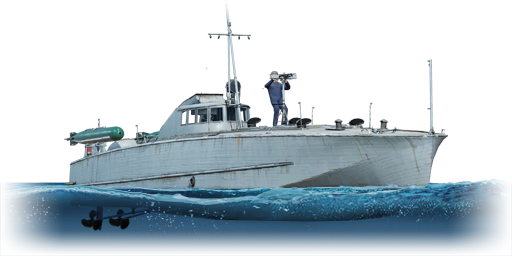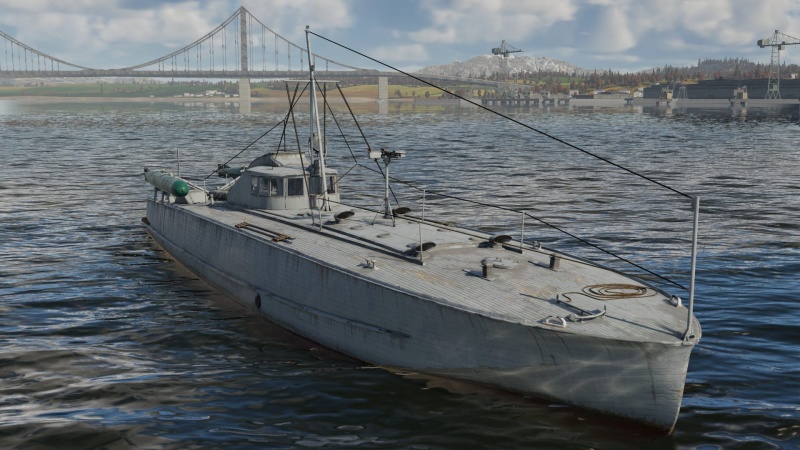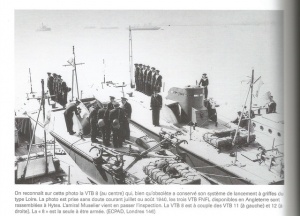Difference between revisions of "VTB-8"
(Added section on Darne M1922 machine gun.) (Tag: Visual edit) |
(Added history section for VTB-8.) (Tag: Visual edit) |
||
| Line 30: | Line 30: | ||
<!-- ''Provide information about the characteristics of the primary armament. Evaluate their efficacy in battle based on their reload speed, ballistics and the capacity of their shells. Add a link to the main article about the weapon: <code><nowiki>{{main|Weapon name (calibre)}}</nowiki></code>. Broadly describe the ammunition available for the primary armament, and provide recommendations on how to use it and which ammunition to choose.'' --> | <!-- ''Provide information about the characteristics of the primary armament. Evaluate their efficacy in battle based on their reload speed, ballistics and the capacity of their shells. Add a link to the main article about the weapon: <code><nowiki>{{main|Weapon name (calibre)}}</nowiki></code>. Broadly describe the ammunition available for the primary armament, and provide recommendations on how to use it and which ammunition to choose.'' --> | ||
{{main|Darne M1922 (7.7 mm)}} | {{main|Darne M1922 (7.7 mm)}} | ||
| − | + | ''Provide information about the characteristics of the primary armament. Evaluate their efficacy in battle based on their reload speed, ballistics and the capacity of their shells. Add a link to the main article about the weapon: <code><nowiki>{{main|Weapon name (calibre)}}</nowiki></code>. Broadly describe the ammunition available for the primary armament, and provide recommendations on how to use it and which ammunition to choose.'' | |
| − | |||
| − | |||
| − | |||
| − | |||
* '''Universal:''' {{Annotation|AP|Armour-piercing}}{{-}}{{Annotation|T|Tracer}}{{-}}{{Annotation|AP|Armour-piercing}}{{-}}{{Annotation|T|Tracer}} | * '''Universal:''' {{Annotation|AP|Armour-piercing}}{{-}}{{Annotation|T|Tracer}}{{-}}{{Annotation|AP|Armour-piercing}}{{-}}{{Annotation|T|Tracer}} | ||
| Line 72: | Line 68: | ||
== History == | == History == | ||
<!-- ''Describe the history of the creation and combat usage of the ship in more detail than in the introduction. If the historical reference turns out to be too long, take it to a separate article, taking a link to the article about the ship and adding a block "/History" (example: <nowiki>https://wiki.warthunder.com/(Ship-name)/History</nowiki>) and add a link to it here using the <code>main</code> template. Be sure to reference text and sources by using <code><nowiki><ref></ref></nowiki></code>, as well as adding them at the end of the article with <code><nowiki><references /></nowiki></code>. This section may also include the ship's dev blog entry (if applicable) and the in-game encyclopedia description (under <code><nowiki>=== In-game description ===</nowiki></code>, also if applicable).'' --> | <!-- ''Describe the history of the creation and combat usage of the ship in more detail than in the introduction. If the historical reference turns out to be too long, take it to a separate article, taking a link to the article about the ship and adding a block "/History" (example: <nowiki>https://wiki.warthunder.com/(Ship-name)/History</nowiki>) and add a link to it here using the <code>main</code> template. Be sure to reference text and sources by using <code><nowiki><ref></ref></nowiki></code>, as well as adding them at the end of the article with <code><nowiki><references /></nowiki></code>. This section may also include the ship's dev blog entry (if applicable) and the in-game encyclopedia description (under <code><nowiki>=== In-game description ===</nowiki></code>, also if applicable).'' --> | ||
| − | + | Impressed by the success of the British and Italian torpedo boat fleets during WW1, the French navy bought two boats from the British company Thornycroft in 1921 for use as testbeds. These boats were given the designation VTA-1 and VTB-1, shorthand for "vedette torpilleur" with an A appended for small boats, and B appended for boats carrying two or more torpedoes. A handful of experimental boats followed, leading to the construction of VTB-8 and VTB-9 in 1935 - a series of two craft, and the first to be designed and built entirely by the French. Powered by two marine petrol engines with a combined 2,200 horsepower, the boat was designed to run at 46 knots (85.2 km/h) with a maximum laden speed of 48 knots (88.9 km/h). If unladen with equipment, however, VTB-8 proved that speeds of nearly 52 knots (96.3 km/h) were possible. This emphasis on speed was questioned, however, when VTB-9 broke apart and sank at top speed near Barfleur on the 9th of August, 1939. More difficulties arose when it was found that the Loire claw system responsible for suspending and dropping the 45 cm torpedoes into the water, suffered from fragility and a lack of precision. For these reasons, no other boats of the class were constructed. VTB-8 continued to serve in some capacity during WW2, being transferred to Britain under the name B063 shortly before the surrender of France, and was present at the evacuation of Dunkirk. In 1941, it was transferred back into the service of the free French forces, before being decommissioned in January of 1944, a few months before the war ended. | |
== Media == | == Media == | ||
<!-- ''Excellent additions to the article would be video guides, screenshots from the game, and photos.'' --> | <!-- ''Excellent additions to the article would be video guides, screenshots from the game, and photos.'' --> | ||
''Excellent additions to the article would be video guides, screenshots from the game, and photos.'' | ''Excellent additions to the article would be video guides, screenshots from the game, and photos.'' | ||
| + | [[File:Vtb-8-fnfl-1.jpg|thumb|VTB-8 undergoing testing at Cherbourg in 1933.]] | ||
== See also == | == See also == | ||
| Line 93: | Line 90: | ||
* [[wt:en/news/9050-development-french-coastal-fleet-closed-testing-begins-soon-en|[Devblog] French Coastal Fleet Closed Testing Begins Soon!]] | * [[wt:en/news/9050-development-french-coastal-fleet-closed-testing-begins-soon-en|[Devblog] French Coastal Fleet Closed Testing Begins Soon!]] | ||
| + | * https://forum.warthunder.com/t/vtb-8-the-first-operational-motor-boat-of-the-french-navy/28626 | ||
| + | * http://www.ww2ships.com/france/f-sc-001-b.shtml | ||
| + | * http://www.navypedia.org/ships/france/fr_cf_vtb8.htm | ||
{{ShipManufacturer Ateliers et Chantiers de la Loire}} | {{ShipManufacturer Ateliers et Chantiers de la Loire}} | ||
{{France boats}} | {{France boats}} | ||
Revision as of 22:03, 24 September 2024
Contents
Description
The VTB-8 is a rank I French motor torpedo boat with a battle rating of 1.0 (AB/RB/SB). It was introduced in Update "Dance of Dragons".
General info
Survivability and armour
As with all reserve torpedo boats, there is no real armour to speak of. VTB-8's 40mm thick wooden hull and 15mm thick wooden superstructure is typical of early torpedo boats and is shared with the MAS-561, PT-6, and Type T-14. The radio station and pilothouse are relatively small and set roughly amidships, which reduces the size of the target the enemy needs to hit to damage the craft's steering. The single gun mount is very small and therefore hard to disable, which will allow you to keep firing in desperate situations. If it is somehow destroyed, it won't affect your overall crew count. In total, the boat can hold ten crew members, with three in each hull section and one in the pilothouse, needing a minimum of three crew to operate.
Mobility
The boat is surprisingly agile, but it's primary asset is its speed. Being faster than any reserve boat other than the Russian G-5, you can beat the competition to the capture point, escape from big ships, and close the distance with the enemy as needed.
| Mobility Characteristics | |||
|---|---|---|---|
| Game Mode | Upgrade Status | Maximum Speed (km/h) | |
| Forward | Reverse | ||
| AB | |||
| Upgraded | 125 | 37 | |
| RB/SB | |||
| Upgraded | 89 | 26 | |
Modifications and economy
Armament
Primary armament
Provide information about the characteristics of the primary armament. Evaluate their efficacy in battle based on their reload speed, ballistics and the capacity of their shells. Add a link to the main article about the weapon: {{main|Weapon name (calibre)}}. Broadly describe the ammunition available for the primary armament, and provide recommendations on how to use it and which ammunition to choose.
- Universal: AP · T · AP · T
- 7.7 mm AP belt: AP · AP · AP · T
- 7.7 mm API belt: IT · IT · IT · IT
| Penetration statistics | |||||||
|---|---|---|---|---|---|---|---|
| Ammunition | Penetration @ 0° Angle of Attack (mm) | ||||||
| 10 m | 100 m | 500 m | 1,000 m | 1,500 m | 2,000 m | ||
| T | 9 | 8 | 7 | 6 | 5 | 4 | |
| AP | 9 | 9 | 8 | 6 | 5 | 5 | |
| IT | 8 | 8 | 6 | 5 | 4 | 4 | |
| Shell details | ||||||||||||
|---|---|---|---|---|---|---|---|---|---|---|---|---|
| Ammunition | Velocity (m/s) |
Projectile mass (kg) |
Fuse delay | Fuse sensitivity (mm) |
Explosive mass (TNT equivalent) (g) |
Ricochet | ||||||
| 0% | 50% | 100% | ||||||||||
| T | 835 | 0.01 | - | - | - | 47° | 56° | 65° | ||||
| AP | 830 | 0.01 | - | - | - | 47° | 56° | 65° | ||||
| IT | 830 | 0.01 | - | - | - | 47° | 56° | 65° | ||||
Additional armament
Describe the available additional armaments of the ship: depth charges, mines, torpedoes. Talk about their positions, available ammunition and launch features such as dead zones of torpedoes. If there is no additional armament, remove this section.
Usage in battles
The boat is very fast for a reserve vessel, beating out all but the sleek duralumin G-5 for top speed. This can be used to your advantage when attacking capture points or for closing the distance with your enemy - something you will need to do regularly to achieve any sort of lethality from your small calibre weapons. The tripod gun mount provides an excellent 360 degree firing arc as well as between -10 and 80 degrees of elevation for use against aircraft. Keeping this in mind, it's best to attack all targets "bow-in" to expose as little of your hull as possible. Given the wooden construction, it's not the best boat for "bow-tanking" but that is by far your best hope for survival against aware enemies. As with all belt-fed weapons, managing your reloads is key. However, with a weapon of this low calibre, you need as many bullets as possible to be ready before you hit that several second reload downtime. If you believe an engagement is coming up or lack visibility on the threats ahead, make sure to empty your magazine and get a fresh one.
Pros and cons
Pros:
- Fast and agile
- Stable gunnery platform at high speeds
- 360° arc of fire for both guns, with very good vertical guidance
- Good survivability for the BR
- Small silhouette
- Tiny steering gear is very unlikely to suffer critical damage
Cons:
- Poor firepower
- Limited selection of ammunition
- Very short range of the torpedoes, making them extremely situational
History
Impressed by the success of the British and Italian torpedo boat fleets during WW1, the French navy bought two boats from the British company Thornycroft in 1921 for use as testbeds. These boats were given the designation VTA-1 and VTB-1, shorthand for "vedette torpilleur" with an A appended for small boats, and B appended for boats carrying two or more torpedoes. A handful of experimental boats followed, leading to the construction of VTB-8 and VTB-9 in 1935 - a series of two craft, and the first to be designed and built entirely by the French. Powered by two marine petrol engines with a combined 2,200 horsepower, the boat was designed to run at 46 knots (85.2 km/h) with a maximum laden speed of 48 knots (88.9 km/h). If unladen with equipment, however, VTB-8 proved that speeds of nearly 52 knots (96.3 km/h) were possible. This emphasis on speed was questioned, however, when VTB-9 broke apart and sank at top speed near Barfleur on the 9th of August, 1939. More difficulties arose when it was found that the Loire claw system responsible for suspending and dropping the 45 cm torpedoes into the water, suffered from fragility and a lack of precision. For these reasons, no other boats of the class were constructed. VTB-8 continued to serve in some capacity during WW2, being transferred to Britain under the name B063 shortly before the surrender of France, and was present at the evacuation of Dunkirk. In 1941, it was transferred back into the service of the free French forces, before being decommissioned in January of 1944, a few months before the war ended.
Media
Excellent additions to the article would be video guides, screenshots from the game, and photos.
See also
Links to articles on the War Thunder Wiki that you think will be useful for the reader, for example:
- reference to the series of the ship;
- links to approximate analogues of other nations and research trees.
External links
- [Devblog] French Coastal Fleet Closed Testing Begins Soon!
- https://forum.warthunder.com/t/vtb-8-the-first-operational-motor-boat-of-the-french-navy/28626
- http://www.ww2ships.com/france/f-sc-001-b.shtml
- http://www.navypedia.org/ships/france/fr_cf_vtb8.htm
| Ateliers et Chantiers de la Loire (ACL) | |
|---|---|
| Motor Torpedo Boats | |
| VTB-8-class | VTB-8 · VTB-9 |
| VTB-11-class | VTB-11 · VTB-13 · VTB-14 |
| Destroyers | |
| Jaguar-class | Leopard |
| Battleships | |
| Bretagne-class | Lorraine |
| See also | Loire Aviation |
| France boats | |
|---|---|
| Motor torpedo boats | VTB-8 · VTB-9 · VTB-11 · VTB-14 |
| VLT-1 · VLT-2 · VTB-19 | |
| MTB-96 | |
| Motor gun boats | L9059 · La Combattante · VTB-13 |
| Gunboats | La Suprise |






